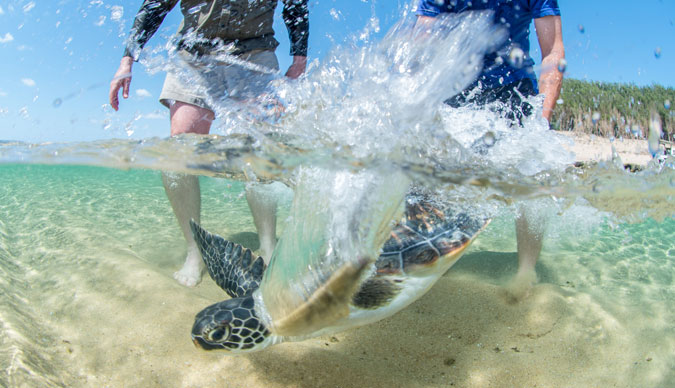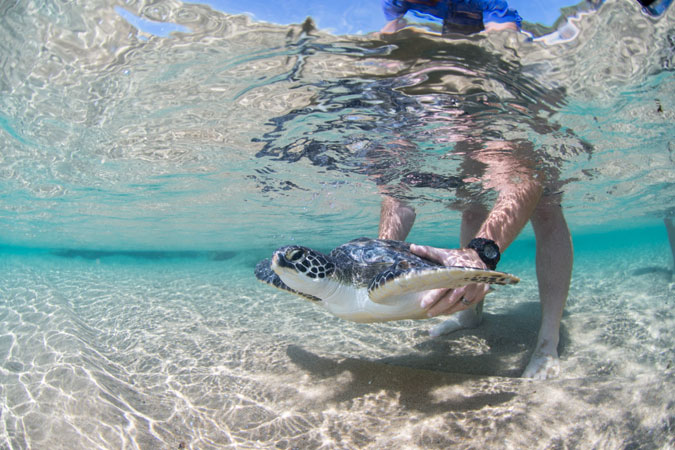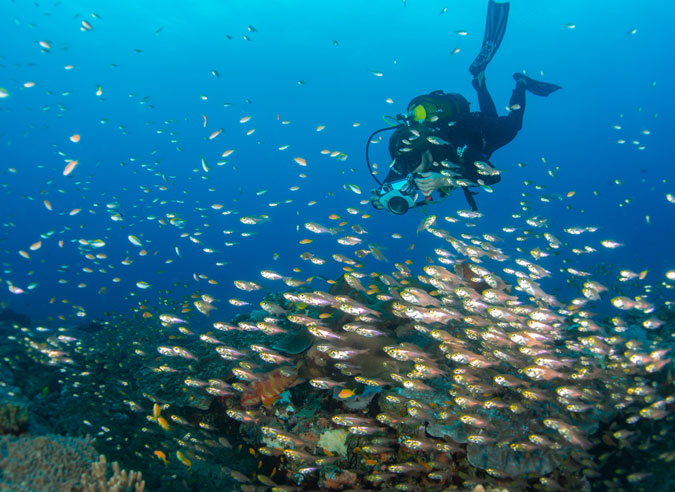Sodwana Bay, in the iSimangaliso Wetland Park, boasts the southernmost reaches of the tropical west Indian Ocean and a population of green turtles.
On 28 November 2016, two rehabilitated green turtles (Chelonia mydas) nicknamed ‘Mel’ and ‘Grotto’, were released here at Mabibi by park CEO Andrew Zaloumis and senior aquarist Robert Kyle from SAAMBR (South African Association for Marine Biological Research).

Each year, concerned members of the public take stranded turtles to local vets or into Aquaria around the country. This release was part of ongoing rehabilitation measures undertaken by iSimangaliso together with the Two Oceans Aquarium in Cape Town, uShaka Marine World in Durban and Bayworld in Port Elizabeth.
During winter, juvenile turtles are swept down from the northern coast of KwaZulu-Natal in the Agulhas current. They are often in a weak condition and could be dehydrated or hypothermic, or worse, injured in some way.

Green turtles don’t nest on our beaches, but rather on the beaches alongside the Mozambique Channel. However, they are common in the South African offshore waters. Of the two turtles that were released, little Mel is the smallest weighing 816 grams. She was stranded at the Willows outside Port Elizabeth on 16 December 2015 and treated at Bayworld for ‘shell rot’. She recovered completely. As Mel was treated medically she could be sexed.

The second turtle ‘Grotto’ was stranded on Grotto Beach near Cape Town on 29 April 2016. This turtle weighs 12.6 kg. Grotto cannot be sexed as green turtles only become sexually mature at 50 years old. This is just one of the reasons why saving, rehabilitating and releasing Green turtles back into the wild is so vital.

Both turtles were rehabilitated at Two Oceans Aquarium in Cape Town and then sent up to uShaka Marine World where they were observed for a few weeks before being released inside the marine protected area of the wetland park.
The Two Oceans Aquarium in Cape Town started releasing larger numbers of rehabilitated turtles in 2009, starting off with eight. Within only six years the numbers have increased dramatically and in 2015, 162 turtles were released back into the wild.
A proportion of the Shootout event entry fees contribute directly towards the iSimangaliso Rare and Endangered Species Fund which is used exclusively for the protection, reintroduction, monitoring and research of species such as these two turtles, within the park.

Zaloumis told me that, “this year for the first time, the fund is contributing to marine species conservation. R100 000 has already been allocated to a project on the ecological state of the coral reefs in the area.”
Zaloumis hopes both to increase awareness, and also to improve the efforts being made by the iSimangaliso Authority to protect and conserve marine areas.
Visitors to the park at this time of year (November through to March) could witness the miracle of egg-laying and the hatching of loggerhead and leatherback turtles. Watching a huge mother turtle lumber down the dunes and slip silently into the dark waves after covering her eggs in a deep sandy nest is strangely moving.
As I witnessed the release of Grotto and Mel back into the wild waters I noticed more than a few wet eyes amongst those involved. I hope my photos impart some of the emotion of that moment – a moment everyone present will remember forever.
To comment on this story: Login (or sign up) to our app here - it's a troll-free safe place 🙂.![]()






